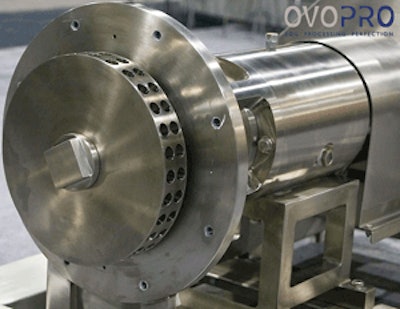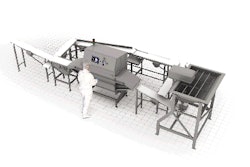
The breaking and further processing segment of the U.S. egg industry operates efficiently but with less public or media attention than shell egg production. Further processing represents the equivalent output of almost 100 million hens. Approximately 30 percent of eggs produced in the United States undergo breaking in addition to Smalls and surplus shell eggs.
The industry has expanded from approximately 10 percent of eggs broken during the mid-1970s to the present volume. Some industry observers forecast that 50 percent of eggs will be subjected to further processing by 2020.
Demand for pasteurized liquid increased sharply with the advent of Salmonella enteritidis (SE) in the late 1980s and early 1990s. Purchase of liquid by the food service industry and institutional kitchens provided absolute protection against infection at a time when control of SE was less advanced than today. Liability suits with resulting insurance costs and adverse publicity stimulated adoption of liquid by food service providers.
Concern over cholesterol also led to the production and marketing of consumer packs of specially modified liquid products derived from egg breaking.
Breaking, processing status
Currently the structure of the breaking segment of the egg industry is diverse. The fastest growing and largest part involves in-line operations dedicated to breaking. These units, mostly situated in the Midwest, generally hold from 2 to 4 million hens. The strain of hens, dietary formulation, design of housing and equipment and production cycles are selected to optimize efficiency and product yield.
These in-line operations have breakers. They either ship raw product in bulk or have integrated breaking and pasteurization plants. Older off-line breaking plants receive shell eggs which are broken and then pasteurized on-site or transported to a remote plant.
Specialty plants receive shell eggs and bulk liquid for processing and produce a range of products including whole egg liquid, yolks, albumen with additives in a variety of presentations for institutional and consumer markets. Some in-line plants are equipped to both grade and break.
|
|
Higher demand
According to Santiago Gomez, director of technology for OvoPro, the company formed following the acquisition of Diamond Systems by the parent of Moba in Holland, the demand for powdered egg in Europe has increased by 40 percent over the past five years. Helge Fillipsen, president of Sanovo-Stalkat USA, has observed consolidation in the industry with fewer, larger plants which offer efficiency and economy of scale, creating market opportunities for niche operators. The smaller plants can run limited quantities of specialty products such as eggs derived from cage-free flocks or organic certified product.
Small batches are generally incompatible with larger pasteurizing plants. Changing items requires plants to strip equipment and clean which is time-consuming and detracts from optimum efficiency. This prompted Michael Foods, the largest U.S. processer of eggs, to acquire the Abbotsford operation in Wisconsin which has capacity and equipment consistent with a full line of products, but limited volume.
USDA market reports and industry price discovery services indicate that shell eggs are purchased at 67 percent of prevailing weekly prices for specific grades.
In many respects egg processors are in the same position as oil refiners. Recent experience has demonstrated that there are limits to the ability of refiners to pass the higher cost of crude to consumers in the price of gasoline. Profitability, determined by what is termed the "crack spread", relates to the catalytic cracker pivotal to the refining process.
The egg industry has a similar "crack spread" which determines profitability. The cost of breaking stock varies according to shell egg supply and demand. The selling prices of pasteurized products, generally independent of the shell market, are relatively fixed. Rising egg prices erode margins since the supply of shell eggs from independent producers comprising surplus diminishes in inverse proportion to price.
Exports of processed products do not represent a significant proportion of production since the cumulative value of shipments over the first seven months of 2008 attained $52 million, a 20 percent increase over the corresponding period in 2007 mainly due to an escalation in unit price, not volume. Japan represents the largest long term importer from the United States but in 2008, Germany, Mexico and Denmark on average doubled their purchases although over a small base.
A small but growing segment of the further processing industry comprises the production of added value breakfast products for consumers and restaurants. Hard cooked peeled eggs are an emerging product with at least six plants processing and distributing medium-grade eggs in brine in bulk packs for catering and more sophisticated modified atmosphere sealed pouches and trays for consumers. The significant challenge will be to develop menu items which are suitable for quick service restaurants and a wider range of consumers.
Breaking equipment
Many plants operate with refurbished Seymour breakers rated at 80 to 100 cph. With pasteurizing plants operating at 30,000 to 60,000 pounds per hour, the need for larger capacity breaking equipment is evident.
Sanovo recently introduced the OptiBreaker with capacities from 150 to 450 cph. These units have a unique stacked design with a small footprint. Computerized scanning vision of the separation cup allows real-time monitoring of the separation of yolk from albumen. The system detects and limits yolk contamination of albumen with resulting improved attributes under commercial use. This feature requires passage of light through a translucent receiving cup which contains albumen.
The polypropylene cups have rounded edges which improve efficiency of cleaning-in-place (CIP) during operation and at the termination of processing. Cleaning is efficient since polypropylene has a smooth surface as denoted by electron microscopy. The use of plastic components also reduces noise levels resulting in a more acceptable workplace. Sabic polypropylene material conforms to European Union requirements and is accepted by the USDA as a contact surface for dairy and egg processing installations. Sanovo claims optimal yield from the design and location of the breaker bar and the method of tilting the cup to allow draining over five seconds.
OvoPro markets the U.S. Diamond egg breakers following restructuring of the Diamond and Moba affiliates. These units have a linear configuration and are available as breakers or combination breaker-separators. OvoPro claims high purity of egg white with a fat content of less than 0.03 percent.
An electronic yolk scanner automatically detects contamination of egg whites. OvoPro breaker-separators have an exclusive zoned cup wash system maximizing cleanliness and conserving water. The electronic monitoring system interface provides a total eggs processed read-out with records of performance of each cracker to identify malfunctions and optimize efficiency.
Variety of features
OvoPro offers centrifuges which can process up to 280,000 shells per hour. Features include basketless operation using a cone-auger and a time release lubrication module. Operating temperature, product depth, retention time and air flow are variable.
Diamond has developed a unique "Breaker-in-a-Box," a turnkey egg breaking system installed and operational in a 40-foot shipping container. The module is capable of breaking, filtering and pasteurizing up to 100 cph or 450 gallons of whole-egg per hour. These units are designed for rapid transport and deployment adjacent to a specific egg plant and can operate in consistency with marketing or sanitary needs.
Liquid handling and pasteurization
Sanovo Stalkat offers a complete range of liquid handling pasteurization and filling equipment with accessory CIP systems, albumen treatment and drying. A range of collection vats to receive egg liquids, coolers to reduce the temperature of yolk, albumen or whole egg liquid, egg pumps and filters to remove egg shells and impurities are required. Sanovo pasteurizing plants are designed to promote long shelf life. Ancillary equipment can provide flexibility to produce specialty products incorporating salt, sugar and other additives. Pasteurizer capacity ranges from 150 to 2,500 gallons per hour and incorporates CIP and modifications to conserve water and energy.
Ultra-filtration and reverse osmosis are offered by Sanovo to reduce the moisture content of albumen prior to drying. Systems incorporate horizontal spray drying which reduces space requirements in plants especially when retrofitting. Installations can dry whole egg to 3 percent moisture content at a rate ranging from 50 pounds per hour to 1,500 pounds per hour. Yolk and egg white can be dried to 3 percent and 7.5 percent moisture content respectively with maximum capacities of 3,500 pounds per hour and 1,200 pounds per hour.
A full range of further processing equipment from OvoPro provides filtration and cooling, holding tanks with CIP and pasteurizers which range in capacity from 100 to 10,000 pounds per hour. The patented double-wall regeneration section is designed to operate without pressure differential controls or low efficiency water-egg-water systems. OvoPro pasteurizing installations incorporate a PLC controller with a touch screen interface. The OvoPro Shock units function as homogenizers by applying the principle of cavitation under pressure which generates heat energy. Microscopic bubbles are produced as liquid is passed through the unit and the energy released as the bubbles implode results in heating and microscopic mixing. The application of OvoPro Shock equipment allows for pasteurization at high temperature for extended time periods while preserving functionality of the product.
Filling systems can involve ultra clean or aseptic distribution of product. Presentations range from bulk tanks, refrigerated totes, plastic buckets, bag-in-box or screw-cap cartons for consumer purchase.
Hard-boiled egg processing
Sanovo offers complete lines which cook and peel eggs at rates from 25 to 60 cph. The cooker incorporates a system which centers yolks. Peeling results in a smooth albumen for optimal presentation of high-grade product. Hard-cooked peeled eggs are usually packed in pouches or trays with modified atmosphere packaging comprising nitrogen and carbon dioxide and less than 0.5 percent oxygen.
To obtain acceptable shelf life, special multi-ply barrier pack bags are used which maintain anaerobic conditions until packs are opened. Some plants in the United States further-process hard-cooked peeled product into deviled eggs which are sold as kits containing half egg whites and yolk mixed with paprika and other spices.
The bottom line
Further-processing of eggs will represent a greater proportion of total U.S. production in the future. Present preoccupation with generic eggs can be compared to the status of the broiler industry in the 1960s. Industry growth and continued profitability of broiler meat production has resulted from portioning and further processing to enhance value and provide convenience to consumers and food service.
Promotion of eggs by industry groups and the American Egg Board has emphasized nutritional value. Educational materials and research priorities have of necessity focused on countering misinformation regarding an alleged relationship between dietary cholesterol intake and cardiovascular disease.
It is now appropriate to develop new products which require breaking and separation of components followed by pasteurization as the first step. The unique and beneficial nutritional and physical attributes of yolks and albumen can be combined with other ingredients to create products which generate additional indirect demand for eggs.





.jpg?auto=format%2Ccompress&fit=crop&h=167&q=70&w=250)











